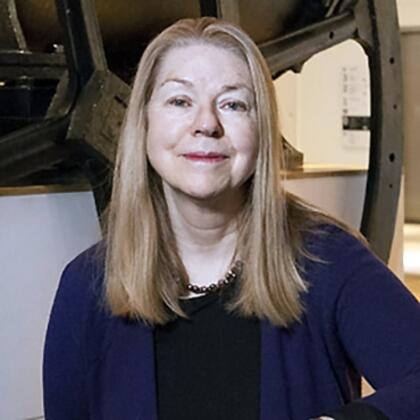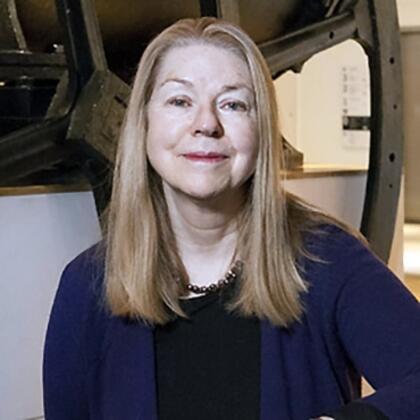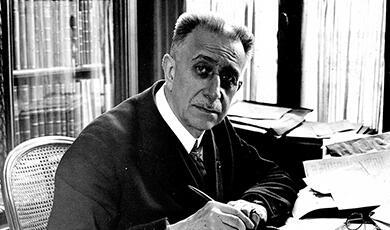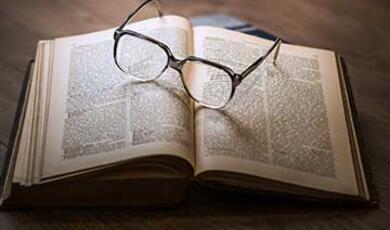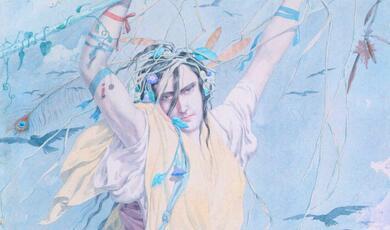Portraits, Biographies and Public History
Share
- Details
- Text
- Audio
- Downloads
- Extra Reading
Immense curiosity exists about the lives of people who lived in the past. Portraits and biographies play a major role in bringing the dead to life, but they may mislead and distort as much as they illuminate. Using writings about nineteenth-century British figures alongside images of them, Professor Ludmilla Jordanova will explore the intertwined roles of biography and portraiture in public history, suggesting ways in which it is possible to be constructively critical of current practices.
Download Text
In the lecture to honour the memory of Colin Matthew, I pick up themes that relate to his life and work: he edited Gladstone’s diaries and wrote extensively about him; he was the founding editor of the Oxford Dictionary of National Biography between 1992 and 1999, and assessed Millais’s portraits of Gladstone in the catalogue that accompanied an exhibition at the National Portrait Gallery of the artist’s work in 1999. The kernel of the lecture is an exploration of the relationships between portraits, biographies and public history. ‘Public history’ refers to two distinct phenomena. First, it’s a handy term for all the ways in which non-specialists can engage with the past. These range from documentaries, museums and popular non-fiction books to historical novels and all the media. There’s nothing new about the phenomenon - versions of the past in many media have reached large audiences for a very long time. It’s only relatively recently that they have been drawn together, using the phrase ‘public history’. When I was writing the first edition of History in Practice in the 1990s, the term was not familiar to many professional historians practicing in Britain; it was established earlier in North America. In the UK, as elsewhere, there are now a multitude of books, articles, postgraduate courses, and websites that explicitly engage with public history. In its second sense, ‘public history’ has become a field, that explores all the ways in which historical accounts or versions are out there, in the public domain. This exploration has to be grounded in critical analysis that carefully assesses how the past is being represented, in whose interests and with what consequences. Since the UK government has been commenting on these matters, and indeed intervening in what have been labelled ‘culture wars’, public history has become a prominent topic. The media don’t necessarily use the phrase. Nonetheless, some commentators search out and publicise accounts of the past that are widely available - as in National Trust properties and statements - and subject them to harsh criticism. In such ways ‘public history’ is up for grabs, and anyone can weigh in on how the past is presented. While public debate is to be welcomed, it has become ideologically polarised, without an understanding of the nature and use of sources being equally widespread. As a result, now more than ever, we need clear, calm analysis based on evidence and understanding. The lecture does not explicitly deal with controversies around statues, although I touch on that issue in a forthcoming article in Historical Research, November 2021. But the whole approach implicit in it is fully transferrable to other contexts; there may actually be some advantage to considering the relationships between biographies, portraits and public history through less emotive examples.
Portraits are about identity. They are everywhere, and for reasons that have not not been fully explained, occupy an especially prominent place in the Anglophone world, judging by the presence of national portrait galleries in London, Edinburgh, Canberra, Auckland and Washington DC. The websites of all these institutions are worth visiting. Portraits are in streets and on buildings; they are present in innumerable publications and constantly used by the media, hence there is a danger that we take them for granted, which is encouraged by the practice of giving priority to the sitter over the artist. This is common in institutions, such as colleges and libraries, that display portraits of illustrious forbears. Even in biographies, portraits are often mere illustrations, not doing much work and failing to engage readers’ attention. In art history it’s different, of course, although until relatively recently many art historians thought of portraiture as dull, except when executed by artists of the first rank. In fact portraits are multi-layered, full of interest, capable of yielding rich insights whatever one’s interests.
Portraiture has much to offer to those thinking about the themes of work, achievement, fame, celebrity, reputation, public image, power, authority and more. The point is familiar from publications about rulers and the politically powerful. The genre is less often seen as a way into the occupational identities of lower-status groups. I originally started working on portraiture in the early 1990s when I noticed their importance in medical lives, and how closely associated they were with biographies and with the histories that doctors themselves were writing from the seventeenth century onwards. I felt then, and continue to feel that we need to take seriously the deep commitment of those in past to honour their forbears, even when we suspect there is something self-serving about their project. Such commitment is not extinct, with numerous work-based associations continuing to acquire and commission likenesses. Some sitters will be deemed heroes. Nowadays we bandy around claims about heroism quite freely. The intricate processes whereby heroes are made, usually with effort and deliberation, are significant historical phenomena that are of interest to specialist and general readers alike. One excellent way of demonstrating the nature of these processes is through the study of portraits and biographies.
Long before I was invited to deliver this lecture, I developed an interest in John Collier (1850-1934), a portrait painter who depicted many leading people of his time. In 1989 and 2007 the London Portrait Gallery acquired a portrait of Marion, his wife, by him and of him by Marion, painted around the same time. I find such reciprocal portraits fascinating. There are 22 portraits associated with Collier in the collection, including one of George Smith (1824-1901), the publisher who initiated the Dictionary of National Biography. He is far less well known than the first editor, Leslie Stephen (1832-1904), a major man of letters. He in turn has been somewhat outshone by his daughter Virginia Woolf (1882-1941). Each work that is taken into the primary collection of the National Portrait Gallery has a “registered packet”, and works are numbered in the order they are acquired. So the portrait of George Smith by John Collier, which is in fact a posthumous work, is NPG 1620; its registered packet contains information on the painting’s conservation and condition, five letters from his widow about the transfer of the work to the Gallery in 1911, the text of labels, and a printed pamphlet that details a dinner held in Smith’s honour in 1894 by the contributors to the Dictionary. Smith is an intriguing person, who played a major role in literary life in London in the second half of the nineteenth century. As a result, literary specialists are far more familiar with him than historians, I have observed. Doing the research for this lecture thus raised questions for me about the relationships between historians and literary critics, as well as about the nature of biography, especially in relation to writers. (See the website npg.org.uk for further information on the collection.)
One aspect of working in this area - portraits, biographies and history-writing - is the ways we can track associations between people, and then reflect of what insights they provide, not least about the quality of interpersonal relationships. It feels tentacular - that by tracking all these links one reaches into a wide range of places, families, organisations and topics, including the histories of publishing and collecting, to cite two examples that don’t feature prominently in the lecture, but are implicit throughout. As I have noted, members of many professions and institutions collect items that are directly relevant to their work and to the life and status of the organisations in question. While it may tempting to see these enthusiasms as characteristic of a nineteenth-century attachment to creating national projects - the National Portrait Gallery and the Dictionary of National Biography, for example - or as an especially nineteenth-century predilection for biography, evidenced by the proliferation of ‘lives and letters’, this would not be accurate.
In the lecture I mention the Memoirs and Letters of Sir James Paget, edited by one of his sons, published in 1901, and adorned with five portraits of Paget, who had died two years earlier. Paget was a prominent surgeon and pathologist. I have a particular interest in portraiture, biography and history in medical contexts, such as the Royal College of Physicians in London. There are many earlier publications that provide evidence of the same drive, of the thirst for details about the lives and appearance of notable people. In the case of Royal College of Physicians, its most famous fellow ever was William Harvey (1578-1657), and he was already being celebrated in books, prints and orations in the seventeenth and eighteenth centuries. Between 1747 and 1766 a seven-volume Biographia Britannica was published, and attempts were made to generate other biographical compendia before George Smith became a very hands on publisher. Smith had amassed a fortune, and knew from the very beginning that the Dictionary would not be income generating. Rather he saw the project as a gift he could bestow on the nation. This much is clear in the autobiography, dictated to a friend, and available in typescript in the National Library of Scotland in Edinburgh. It has been extensively quoted from, but the chance to review it all at first hand was invaluable to get a fuller sense of how he presented his life. Here I can mention just two examples of features that really struck me. The first is that he is totally explicit about money. Of course, providing financial details of the business enabled him to demonstrate precisely how successful he was. Yet I think there is more to it than that, since he discusses his dealings with authors, which indicate the role that money did, or did not play in his dealings with them. He was known to be exceptionally generous to the writers he published, and this manifested itself not just in the deals he struck but in the hospitality he offered. Smith was a man of high intelligence, cultural sensitivity and business acumen with a prodigious ability for hard work. The second feature is his receipt of an honorary degree from the University of Oxford in 1894, which clearly meant a very great deal to him; it was recognition by a leading university of a man who had not benefitted from that level of education himself. This theme is echoed in the letters from his widow to the National Portrait Gallery when she transferred John Collier’s portrait of him. She is perfectly explicit that she and her family appreciate the honour of a portrait in this national institution, one that acknowledges his ‘work for literature’, as she puts it. It would be wonderful to find evidence of exactly how Collier went about painting Smith’s portrait. He was not present at the 1894 dinner I mentioned, which, as noted above, was about contributors thanking Smith. But in 1879 he prepared some drawings for Thackeray. Collier’s Sitters’ Book, available for consultation in the Portrait Gallery’s archive, indicates that the originals were in the possession of George Smith. Given Smith’s prominence in London life, it is likely that they knew each other, but I can’t say more at present. However, Leonard Huxley wrote a book about Smith, published in 1923; Collier had married into the Huxley family in 1879, making him Leonard’s brother in law, so the circumstantial evidence is suggestive. The main point here, however, is the role of portraits and portrait-painting in such webs of association and their potential to be used more extensively in public history, not as decorations but as deposits of relationships, eloquent testimonies and visual commentaries.
George Smith deserves to be more widely known beyond literary circles. Indeed, he could be presented in the context of public history. This example points up a larger phenomenon that underpins all public history. The information I have just given is freely available, the archive of the National Portrait Gallery, like the National Library of Scotland, is open to all. The Gallery’s website contains an image of Smith’s portrait and much research material. The people I have mentioned are discussed in the Oxford Dictionary, which is available free in many public libraries and that includes remote access for their members. In putting it this way, I am highlighting sources and accounts that are available to the general public. This is a major aspect of public history, but it is not the only one. Just as important are the historical activities of those who do not earn a living as historians - people writing family history or local history out of love and attachment. They too trace associations and links, follow themes and places through generations. Furthermore they have a great deal to offer to public life.
George Smith’s life is just one element within the longer history of the Dictionary of National Biography and its Oxford offspring. Understanding the processes whereby the dictionary has been made is very different from knowing little snippets about famous people in the past. Such understanding is not a specialist matter, but a facet of public history that enables audiences to appreciate how historical accounts are fashioned. Furthermore, many of the techniques, checking certificates of birth, marriage and death, and checking wills, are operations ‘amateur’ historians undertake all the time. Seeing biographical connections and tracking research processes help to ensure that a sense of the ways in which accounts of the past are made is as widely disseminated at possible. Portraits and biographies are a compelling way of opening up questions about the past, how it is understood, the shifts in reputations that tend to occur in relation to even the most admired figures, the changing status of occupations, and much more. Portraits and biographies touch people, and do so in many different ways, some which may be negative - these subjects do not only bear on the elevation of special people, but also on key figures who are re-evaluated time and time again, and sometimes vilified in the process.
Some professional historians feel ambivalent about biography as a genre. Nonetheless biographies are an important part of cultural life, providing access to the past for many readers. Portraits and biographies go together. It would be fantastic if portraits and portrait-making could be used more extensively in historical writings, and not just as illustrations. In any case ‘portrait’ is an evocative idea, used metaphorically to convey the sense of a faithful rendition. Histories presented to and made by publics are enriched when they reveal research processes and go beyond texts. Combining portraits and biographies, probing their connections and grasping the needs they meet can be fruitful routes to more critical awareness of their careless or manipulative uses in public culture and to enhanced appreciation of their historical significance.
© Professor Jordanova 2021
References and Further Reading
Most of the names mentioned above have an entry in the Oxford Dictionary of National Biography.
Barbara Caine, Biography and History, London, 2018, second edition
Peter Funnell et al, Millais: Portraits, London, 1999, chapter 3 by Colin Matthew, ‘Portraits of Men: Millais and Victorian Public Life’, pp.137-61
Jenifer Glynn, Prince of Publishers: A Biography of George Smith, London 1986
Leonard Huxley, The House of Smith Elder, London, 1923, printed for private circulation
Ludmilla Jordanova, History in Practice, London 2019, third edition, ch.7 on public history
Frederick Maitland, The Life and Letters of Leslie Stephen, London, 1906
Colin Matthew, ed, The Nineteenth Century. The British Isles: 1815-1901, Oxford, 2000, chapter 2 is by Colin Matthew. This work is designed as an accessible introduction.
Robin Myers et al, eds, Lives in Print: Biography and the Book Trade from the Middle Ages to the 21st Century, New Castle Delaware and London, 2002, 171-92
Stephen Paget, ed., Memoirs and Letters of Sir James Paget, London, 1901
Marcia Pointon, Hanging the Head: Portraiture and Social Formation in Eighteenth-century England, New Haven and London, 1993
References and Further Reading
Most of the names mentioned above have an entry in the Oxford Dictionary of National Biography.
Barbara Caine, Biography and History, London, 2018, second edition
Peter Funnell et al, Millais: Portraits, London, 1999, chapter 3 by Colin Matthew, ‘Portraits of Men: Millais and Victorian Public Life’, pp.137-61
Jenifer Glynn, Prince of Publishers: A Biography of George Smith, London 1986
Leonard Huxley, The House of Smith Elder, London, 1923, printed for private circulation
Ludmilla Jordanova, History in Practice, London 2019, third edition, ch.7 on public history
Frederick Maitland, The Life and Letters of Leslie Stephen, London, 1906
Colin Matthew, ed, The Nineteenth Century. The British Isles: 1815-1901, Oxford, 2000, chapter 2 is by Colin Matthew. This work is designed as an accessible introduction.
Robin Myers et al, eds, Lives in Print: Biography and the Book Trade from the Middle Ages to the 21st Century, New Castle Delaware and London, 2002, 171-92
Stephen Paget, ed., Memoirs and Letters of Sir James Paget, London, 1901
Marcia Pointon, Hanging the Head: Portraiture and Social Formation in Eighteenth-century England, New Haven and London, 1993
This event was on Tue, 02 Nov 2021
Support Gresham
Gresham College has offered an outstanding education to the public free of charge for over 400 years. Today, Gresham College plays an important role in fostering a love of learning and a greater understanding of ourselves and the world around us. Your donation will help to widen our reach and to broaden our audience, allowing more people to benefit from a high-quality education from some of the brightest minds.


 Login
Login
